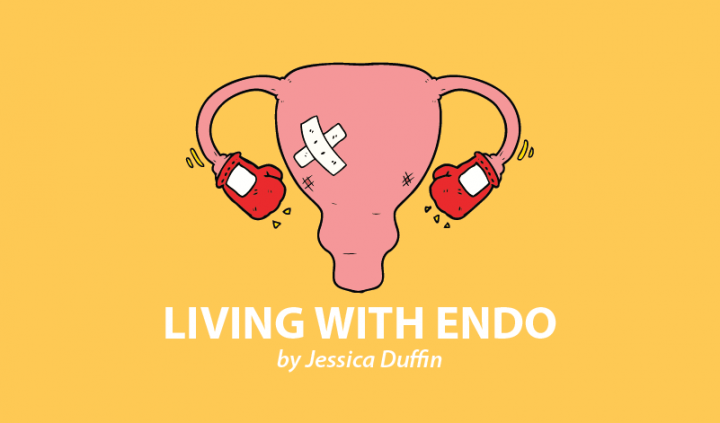An increasingly common theme has been coming up recently: the fear of food. This includes the fear of making wrong choices, of something being “bad,” or of having a flare due to eating.
This fear results in something far more damaging: skipping meals altogether and surviving on low-nutrient foods like cereal bars every now and then.
Lately, I’ve encountered this in several conversations. People are given a list of high FODMAP foods they should avoid due to endo-related irritable bowel syndrome (IBS), but they don’t know what they should eat and how long they should keep up the protocol. As a result, in some cases they’re getting limited nutrients and just one to three servings of fruit and vegetables a day. They’re tired, their brains are foggy, and their endo symptoms are still raging.
I’ve had similar conversations with people who have cut dairy or meat due to feeling inflamed and unwell and being concerned about the risk of endometriosis. While they’ve noticed an improvement in areas such as pain and IBS issues, they’re experiencing new symptoms like severe fatigue and brain fog. Often it turns out they’re not ensuring their diet or supplements include iron, B vitamins, vitamin D, and sufficient protein, and they’re generally eating fewer meals that mainly consist of simple carbohydrates.
I’m noticing many people making changes to their diet without knowing how to accommodate for those changes. And it’s totally understandable. There’s a wealth of information out there, and if we read something that doesn’t also include how to add nutrients, we might be unaware that we’re cutting nutrients out. And when we’re in pain or have other symptoms, it’s natural for us to want to make a change to bring about relief as soon as possible.
But I have a suggestion: Before you make a dietary change to help manage endometriosis, even if it’s a change I talk about in these columns or on my podcast, make sure you do some of your own research and formulate a plan.
For example, if you decide you want to cut down on your dairy intake, don’t just start skipping breakfast because you feel like you can no longer eat cereal. Do some digging as to what dairy-free breakfast recipes are out there. Experiment with nut milks, dairy-free yogurts, and other alternatives. Make sure you read the ingredients and go for high quality — milks with added sugar and lots of additives aren’t going to do your system any favors.
Also, consider what kind of nutrients you might need to increase in your diet, such as calcium, B vitamins, vitamin D, and protein. For example, you can increase your intake of iron and calcium with nuts, seeds, leafy greens, pulses, and legumes. In some cases, such as with vitamin B12 and vitamin D, it’s often best that you supplement, because you might not get enough of these from plant sources alone.
I am vegan, though I’m not labeling any single diet as good or bad. But it’s clear that an anti-inflammatory diet can be helpful for endometriosis. A diet rich in antioxidants with sufficient nutrients can help our bodies take on endometriosis. An anti-inflammatory diet doesn’t have to be one specific diet; it could be paleo, autoimmune paleo, Mediterranean, vegan, vegetarian, or a mix of all of them. The theme across these diets is that they’re rich in nutrients, and if followed in a healthy way, they can be very anti-inflammatory.
If you’re currently finding yourself stuck in an endo diet rut, check your nutrient intake. Are you missing any vital nutrients from your diet? Are you eating enough fruits and vegetables?
Next, look at your meals. If you’re skipping meal times and surviving on pasta, think about the foods and meals you really enjoy. Then go to Google or Pinterest to see if you can find a healthier version of those foods that allows you to eat an anti-inflammatory diet for endometriosis. For example, if you love mac and cheese but you’re avoiding dairy, could you find an alternative sauce recipe made with butternut squash and nutritional yeast?
If you’re on a FODMAP diet with no end in sight, be aware that the diet has three phases. These two podcast episodes are helpful for understanding the three phases and learning how to reintroduce foods back into your diet.
Finally, if you’re still stuck on how to shift the focus from what not to eat to what to eat, I recently interviewed women’s health expert Dr. Jessica Drummond about how to do this. And my free shopping list includes a wealth of anti-inflammatory and nutrient-dense groceries to add to your diet.
***
Note: Endometriosis News is strictly a news and information website about the disease. It does not provide medical advice, diagnosis, or treatment. This content is not intended to be a substitute for professional medical advice, diagnosis, or treatment. Always seek the advice of your physician or other qualified health provider with any questions you may have regarding a medical condition. Never disregard professional medical advice or delay in seeking it because of something you have read on this website. The opinions expressed in this column are not those of Endometriosis News or its parent company, BioNews Services, and are intended to spark discussion about issues pertaining to endometriosis.

